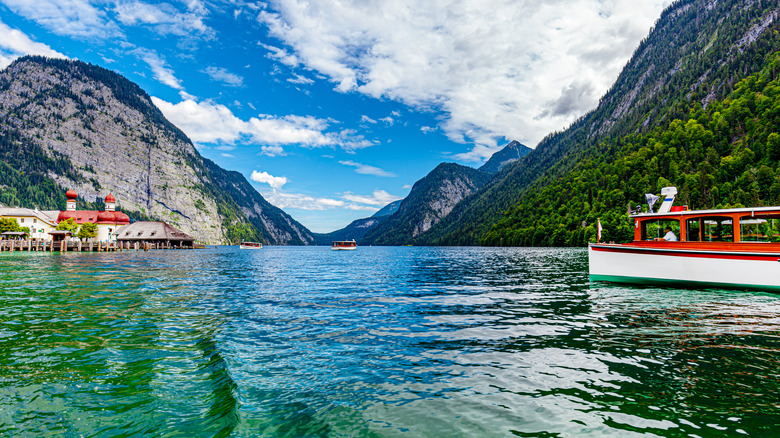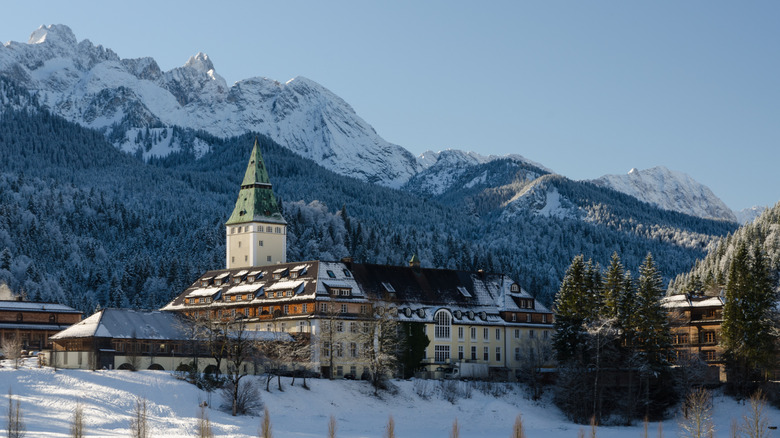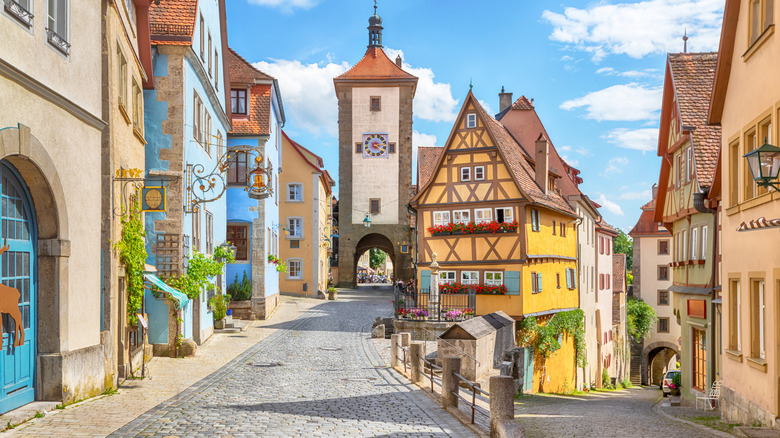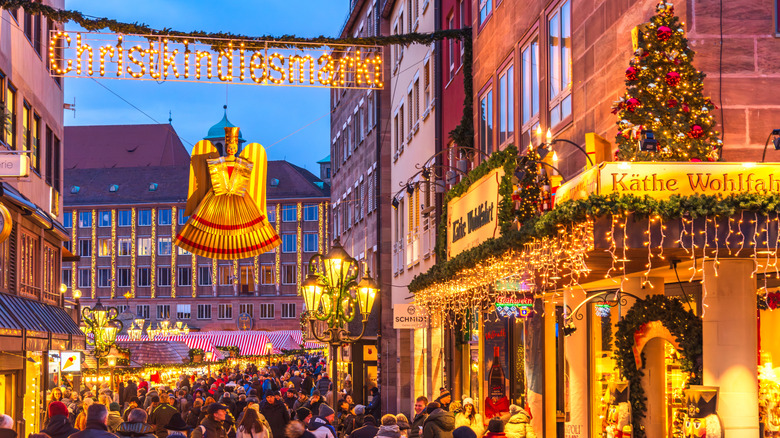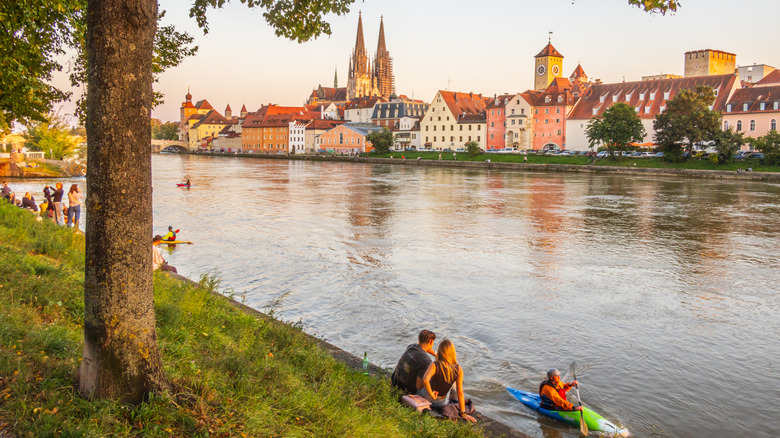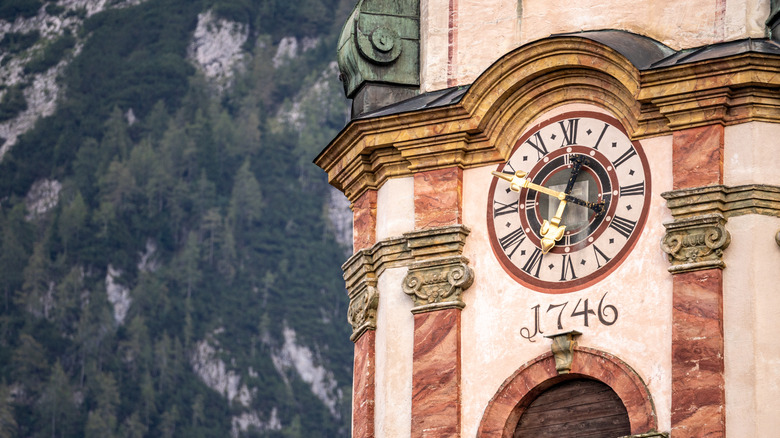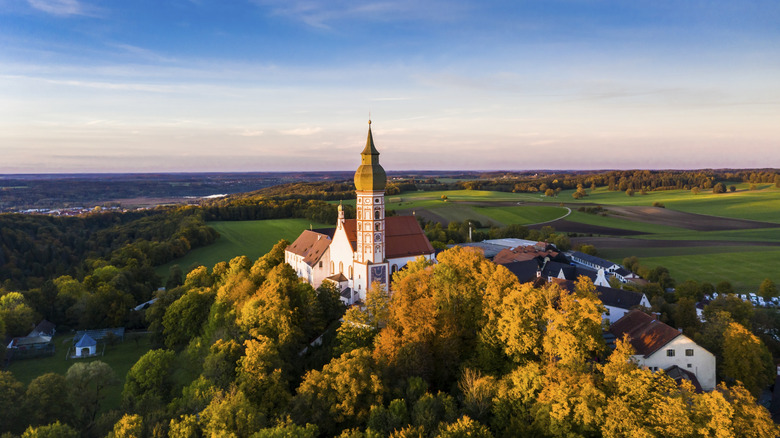Bavaria's 11 Must-See Tourist Attractions You Can't Miss On Your First Trip
Bavaria is a region so intertwined with castles and fairy tales that just the word conjures images of enchanted forests, little red cloaks, horse-drawn carriages, palace balls, and mad kings. Modern-day Bavaria, located in the southeast of present-day Germany, continues to enchant, with palaces high in the mountains, small churches in green fields, and legendary towns where the locals still gather in traditional dress, drinking mugs of foaming beer. To narrow down the list of what first-timers should see in Bavaria, we used recommendations from travel experts and regular travelers alike (via travel websites and review sites), as well as personal experiences. We also sourced info from local tourism boards, destination pages, and local travel news sources to compile a list of the top 11 must-see tourist attractions in Bavaria.
Bavaria delights, from its cozy capital (Munich) and multiple castles to tiny Alpine villages. There's Germany's highest mountain and a mountainous national park, the utter romance of the Romantic Road journey, and towns known for Christmas markets and passion plays — all of which combine to make Bavaria one destination you can't skip on a trip to Germany. If there's one place that's managed to embrace the future while celebrating tradition, it's Bavaria.
Highlights of Munich (Churches, English Gardens, Hofbräuhaus, Hirschgarten, Munich museums)
Munich, Bavaria's capital, is best known for the annual Oktoberfest, but it's also so much more. As the most walkable city in the world, most of Munich's attractions can be connected on foot, which gives you an extra appreciation for this gemütlich (cozy) city, with lively beer gardens, ornate facades, and historical squares, like Marienplatz (St. Mary's Square), the heart of the city. The beer gardens are a must, but so are the art museums — this is a city known for its art and beer, after all. The iconic Hofbräuhaus, a so-called tourist trap that's the best place for authentic Bavarian beer, is a must-visit — in part because of its long history. The Hirschgarten is another favorite, with seats under trees festooned with lights, as is Hofbräukeller am Wiener Platz, which is believed to be the city's original beer garden.
After beer (or maybe before), head to Munich's museums, like the Pinakothek museums. The famous Alte Pinakothek features European artwork from between the 14th and 18th centuries, while the Neue Pinakothek is Munich's home for artists such as Vincent Van Gogh. Modern art lovers need to see the massive Pinakothek der Moderne, technically four separate museums dedicated to facets of modern art like graphics and architecture. Visit the once-royal quarters at the gorgeous Residenzmuseum, or the BMW Museum, a must for anyone interested in automobiles.
Other highlights in Munich include the 15th-century double-spired Frauenkirche, such an iconic symbol of the city that World War II bombers spared it, so they could continue to identify Munich from the air. The grand Königsplatz looks as if it belongs in Greece, and was once a key site for Nazi rallies. Nowadays, it's used for happier occasions, like festivals, and features several museums.
The King's Castles (Neuschwanstein & Hohenschwangau)
Perhaps Bavaria's most iconic destinations are Neuschwanstein Castle (Schloss Neuschwanstein) and its lesser-known neighbor, Hohenschwangau, together the "King's Castles." Neuschwanstein, one of Europe's most mesmerizing cliffside castles (said to have inspired Disney), is what fairy tales are made of; it's perched high in the stunning Alps, featuring fanciful turrets, ornate themed rooms, and jaw-dropping views of peaks and lakes. The castles are touristy, yes, but their allure is undeniable, with lofty Alpine perches making for truly once-in-a-lifetime experiences.
Built during the reign of King Ludwig II, or the "Mad King Ludwig, " Neuschwanstein wasn't quite complete upon his (mysterious) death in 1886. However, Ludwig had essentially dedicated his life, and much of his kingdom's resources, to building this lavish mountain palace, complete with a throne room, grottoes, and the most modern technology on offer in the late 19th century. Deposed shortly before his death, excessive spending on Neuschwanstein was one reason he was removed, although, as travel writer Rick Steves notes, "today nobody complains about the cost of his castles. ... within six weeks of his funeral, tourists were already paying to visit them."
The lesser-known but still romantic Hohenschwangau was the childhood hunting palace of Ludwig. The interior remains much as it did upon construction in 1835, down to a telescope trained on Neuschwanstein from one of Hohenschwangau's lovely bedrooms, where Ludwig could watch the construction of his dream castle from his other castle. The castles can only be visited on tour; however, the best views of Neuschwanstein Castle are from the Marienbrücke bridge, a short walk above. Although most visitors take a day trip from either Munich or nearby Füssen, there are several inns just below Neuschwanstein, with spectacular sunrise and sunset views of the castles from their balconies.
Berchtesgaden National Park & Lake Königssee
Experience more of Bavaria's incredible beauty with a visit to Berchtesgaden National Park, or Berchtesgadener Land. This small knuckle of Bavaria in southeastern Germany is almost entirely surrounded by the Austrian border. The closest airport is around 40 minutes away in Salzburg, while Munich International Airport is about two hours to the northwest. Along with endless hiking trails, endemic wildlife, and stunning scenery, one of the main highlights is the glorious blue Lake Königssee, boasting emerald-green water and scenic Alpine views. Take an electric boat across the lake to the red-domed St. Bartholomew's Church at Pier St. Bartholomew. As you cross the clear turquoise waters, your driver will blow the boat's foghorn, demonstrating the pitch-perfect echo the lake is known for, reverberating off the surrounding cliffs and peaks. While the park is free to enter, various activities require a fee, like the boat tour and certain exhibits at the main visitor center.
There are plenty of lovely hikes in the park, including Röthbach Waterfall, right near the lake. Take the "hiker bus" to various trailheads throughout the park, and to the infamous Eagle's Nest, the former mountain retreat of Adolf Hitler during the Third Reich. The small chalet is simple and mostly provides incredible views, but you can also visit the extensive nearby bunkers, all that remains of the massive, bombed-out Berghof — the headquarters where Hitler spent a full third of his chancellorship.
Garmisch-Partenkirchen & The Zugspitze
The beautiful Garmisch-Partenkirchen is the gateway to Germany's tallest mountain, the Zugspitze, and a must-visit when in Bavaria. Standing at 9,700 feet above sea level, right on the border of Austria and Germany, the dramatic peaks of the Alps stretch as far as the eye can see — on a clear day, you can see four countries. At the summit, as you savor the mind-blowing views, eat in one of the traditional restaurants, or peek through the telescopes, you'll likely be passing back and forth between Austria and Germany. There's a terrace belonging to each country, connected via a walkway that once held a border crossing station, before the countries joined the European Union. To reach the top of the Zugspitze, hop on the Zugspitze cable car or historic cog railway.
Garmisch-Partenkirchen (technically two towns, known as "GaPa") is Germany's mountain sports capital, especially in the winter, with enough pristine slopes, jumps, and levels to satisfy any skier (or snowboarder) of any experience. Both towns have romantic old centers, wooden Alpine chalets aplenty, and world-class aprés-ski cultures. GaPa is approximately one hour from Munich, via car or train, with regular and reliable connections.
Linderhof Palace
There are a lot of must-see castles to visit in Germany, and many of these are in Bavaria, especially considering it's a relatively small area. And a whole lot of Bavaria's many castles seem to be associated with the Mad King Ludwig (yes, him again). Linderhof Palace, near the winter resort of Garmisch-Partenkirchen, was reputedly his favorite, where he spent the majority of his time. Designed as a villa-type retreat, it was the smallest of his three fairy tale-esque palaces, and the only one fully completed during his lifetime, in 1878.
Most of the final years of Ludwig's life were spent in seclusion at Linderhof. At his elaborate dinner table, he reportedly conducted imaginary conversations with his long-dead idols, like the Sun King, and he enjoyed many of his favored operas, usually by Richard Wagner, in his elaborate grotto, complete with a lake where his servants would row him on his swan boat. Visitors to the "Venusgrotte" (Venus Grotto) can still see the otherworldly illumination and the ghostly figure of Ludwig's elaborate boat.
The grounds of Linderhof are a sight in themselves, with paths winding through elaborate hedges, flower gardens, and statue-lined ponds, all surrounded by breathtaking mountain views. Walking around the grounds, it's not hard to see why this was Ludwig's favorite castle. For an extra dose of fairy tale, walk through the mountains to Oberammergau (7.5 miles), the next Bavarian destination on this list.
Oberammergau
The neat streets of Oberammergau, decorated with murals, come alive every 10 years for its world-famous passion play, depicting the story of Christ's trial and execution. This has been a time-honored tradition since the 1600s. According to legend, the villagers prayed to God with a promise that, if they were spared from the rampaging plague, they'd produce a passion play every decade from then on. The tradition has survived since, with very few interruptions (during 2020, for instance, the play was postponed until 2022 on account of the COVID-19 pandemic). Despite its fame, the passion play is still very much a village affair, with the majority of the town involved in the elaborate five-hour production in some way, and all the parts given to locals. Over 2,000 villagers are cast, making Oberammergau's passion play the largest amateur stage production in the world.
The plays are held in years ending in zero, but even if you can't make it to one, Oberammergau is still worth a visit. The colorful homes line streets that frame the tall peaks, the shops are filled with locally-produced products, especially wood carvings, and the surrounding mountains have plenty of recreation opportunities, including a gondola and a spa. Munich is about two hours from Oberammergau by train, while the resort town of Garmisch-Partenkirchen is around 30 minutes away.
Bamberg
Beautiful Bamberg is rightfully on the UNESCO Heritage List, and it's easy to see why, with its flower-lined canals, stone bridges, and colorful half-timbered houses. This medieval town is often considered one of Europe's most beautiful, as well, with its cobbled streets sprawling across seven gentle hills and a river, crowned by the Bamberg Cathedral and scented with the town's traditional smoked beer. Bamberg's Altes Rathaus, or Old Town Hall, is situated in the middle of the Regnitz River, between two bridges, and its picturesque, yellow, half-timbered walls have defied history and gravity for hundreds of years (since 1462). Its intriguing location is because, according to legend, the Bishop of Bamberg refused to give the city's citizens land for their town hall, so they built an island in the middle of the river, instead.
The area around the Altes Rathaus, the former fisherman's quarter, is known as Bamberg's "Little Venice," with many charming buildings (and their tiny, equally charming gardens) seeming to float along the river's edge. For the best views of Little Venice, take a boat cruise down the river. Bamberg's seven hills have given it the moniker "Franconian Rome," and just like in Rome, each hill has its own character, history, and sights. Cathedral Hill is home to the Imperial Bamberg Cathedral, and the tallest of the seven hills is, of course, home to the city's imposing fortress, the Altenburg Castle, standing tall above it all.
The Romantic Road (Rothenburg ob der Tauber)
The full Romantic Road travels between Bavaria and the region of Baden-Württemberg. Following this route through the Bavarian section (and beyond if you wish) connects some of the region's most picturesque, fairy-tale towns. The name is well-deserved, from the cobbled streets of Rothenburg ob der Tauber to the King's Castles near Füssen. The official motto of the Romantic Road — "The journey is the destination" — is also apt, and as you follow the scenic road, the journey itself will showcase the best of Bavaria.
Rothenburg ob der Tauber is one of the most iconic sights on the Romantic Road (and in Bavaria, in general). Rothenburg is so famously charming that it's discovered with a capital "D," but if you time it correctly, you can avoid the worst of the crowds. Even if you come during high season, the colorful, flowered homes, wrought-iron signs, buzzing squares, medieval city walls, and winding alleys are sure to delight.
The Romantic Road covers approximately 217 miles, from Würzburg to Füssen, and while it's well-traveled, especially in the summer, there are plenty of hidden gems. If you come in the fall or winter, the bright leaves or soft snow will add an extra element of atmosphere. Even though the route is relatively short, plan to spend a least a week, to have ample time for exploring the 29 towns, along with rolling vineyards, villages at the foot of the Alps, countryside churches, and hopefully stopping for one of the many festivals.
Nuremberg
Nuremberg is probably most famous for its eponymous trials, when the worst offenders of the Third Reich were put on the stand, and for its Christmas markets (now if that sentence doesn't capture the complexities of Germany...). It's a lovely town in its own right, whether or not you visit during Christmastime, although it must be said that their Christmas markets truly are amazing. However, Bavaria's beautiful second city has everything a traveler could want, with a history dating back to the Middle Ages, a stalwart castle (circa 1140), museums dedicated to ancient German history and modern Nazi atrocities, and one of the country's oldest Christkindlesmarkts. There's nowhere that encapsulates the contrasts of Germany quite like Nuremberg — and in such a lovely package.
Nuremberg's museums are world-class, such as the Germanic National Museum, Germany's largest museum of Germanic history and culture, as well as a charming Toy Museum, and the Museum Tucher Mansion, a beautifully preserved 16th-century merchant home, to name a few. The Memorium Nuremberg Trials and the Documentation Centre are both dedicated to different facets of Nuremberg in World War II, sober reminders of the brutal costs of war and its aftermath. And every December, the Nuremberg Christmas Market, dating back to at least the 17th century, comes to the streets, bringing with it festive songs, delicious drinks, Germany's best treats, lively crowds, locally-made goods, and plenty of fun.
Regensburg
Another UNESCO Heritage Site, the city of Regensburg has roots dating back to the Roman times, and the rich history is evident around every corner — the city is nearly 2,000 years old, after all. Regensburg's location on the Danube adds another element of romance, as do its connecting canals. The first capital of Bavaria, the city has had plenty of time to construct beautiful, historical buildings along its cobbled streets, and needless to say, it delivers. Regensburg has more than 1,000 buildings listed on the historical register, many of them within the UNESCO Heritage Site: the Adler Pharmacy, the Stone Bridge, and the Cathedral Treasury Museum are just a few.
All of this history doesn't equal stodgy or lifeless, though. Regensburg remains a lively, thriving city, and its student population has helped create the highest concentration of bars in the country. The city also features one of the world's oldest boys' choirs (at the Domspatzen) as well as the world's best mustard (Händlmaier) — although that may be a matter of taste.
Mittenwald
Tiny Mittenwald is probably what you imagine when you think of Bavaria: a sweet village high in the mountains, surrounded by jaw-dropping peaks, full of quaint, mural-decorated cottages along a walkable street, lined with dark pubs serving dark beers and bread. Mittenwald, on the edge of the Karwendel Nature Park, is nestled between Munich and Innsbruck and is a handy stopping point between the two cities. Mittenwald began life as a way station on a Roman road and has evolved over centuries to a popular yet cozy resort town, renowned for its murals and dramatic mountain peaks that look close enough to touch. In addition, the violin makers of Mittenwald are known throughout the world for their craftsmanship.
For visitors, Mittenwald's allure lies in its quaint streets, lined with colorful painted houses and even featuring a little stream. The mountains are so close, and the air is so clean that you half expect to turn around and meet Heidi dancing down the street with her grandfather. Although a small dot on the map of Bavaria, it quickly claims the heart of many a traveler. While there, visit a violin workshop to witness the age-old traditions first-hand, or head outside of town to the picturesque Leutasch Gorge to walk along suspended bridges and forested paths.
Methodology
Gathering information from review sites like Reddit and Tripadvisor, travel experts like Rick Steves and various travel writers (some with an international focus, some with a Germany niche), we've aimed to create a list showcasing the best of Bavaria, especially destinations geared toward first-time visitors. Utilizing data gleaned from Bavaria-specific destination sites, such as national park websites or castle websites, we ensured that we were providing the most up-to-date information possible. For locations listed on the UNESCO Heritage List, we went straight to the source. Combining all of the above with personal experience and extensive research, we strived to include destinations that are ideal for first-timers, but also explore a more off-the-beaten-path side of this famous German region.



